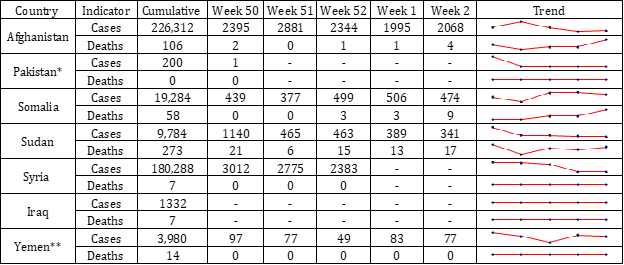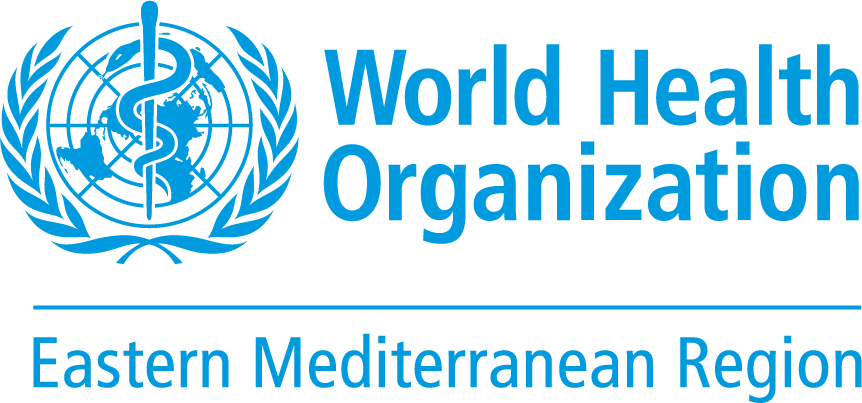As of 13 January 2024, globally, 30 countries reported AWD/cholera outbreaks. In the Eastern Mediterranean Region of WHO, 8 countries namely, Afghanistan, Iraq, Lebanon, Pakistan, Somalia, Sudan, Syria, and Yemen have reported acute watery diarrhea (AWD)/ suspected cholera cases during 2023. In 2024, 7 out of these 8 countries continued to report AWD/ suspected cholera cases. Cholera outbreak in Lebanon was officially announced as closed on 5th June 2023.
During the reporting period (epi week 1-2 2024), 4 member states reported 5,933 new AWD/suspected cholera cases, including 44 associated deaths: Afghanistan (4,063 cases; 5 deaths), Somalia (980 cases; 12 deaths), Sudan (730 cases; 27 deaths), and Yemen (160 cases; 0 death). (Table 1). As of 13 January 2024, 7 member states reported 441,180 AWD/suspected cholera cases, including 465 associated deaths: Afghanistan (226,312 cases; 106 deaths), Iraq (1,332 cases; 7 deaths), Pakistan* (200 cases; 0 death), Somalia (19,284 cases; 58 deaths), Sudan (9,784 cases; 273 deaths), Syria (180,288 cases; 7 deaths), and South Yemen (3,980 cases; 14 deaths:(Table: 1).

Table 1: Number of cases, deaths and trend of AWD/suspected cholera cases reported from 7 member states in the EMR, January 2024
*Pakistan reports only laboratory confirmed cases.
**Data from Northern Yemen were not received.
Note: No updates were received from Pakistan, Iraq, and Syria during the reporting period.
While males and females seem to be almost equally affected by AWD/ suspected cholera in the Region, most of the AWD/ suspected cholera cases in Afghanistan (57%), Both Somalia and Syria (54%) are children under five years of age. In Lebanon and Yemen, children under five years represent 26% and 24% of the total suspected cases respectively. There are many drivers contributing to the resurgence of cholera in the Region, such as climate change, conflict and political instability, weak health systems, increased population movement, poor water and sanitation infrastructure, and low awareness among the public. With the support of WHO and other partners, all cholera-affected countries implemented multisectoral cholera response interventions, including coordination, early warning surveillance, water, sanitation, and hygiene, laboratory diagnosis, clinical case management, risk communication and community engagement, and oral cholera vaccination.
Considering that many countries in the Region are facing natural disasters, political and economic instability, and armed conflicts, it’s critical to enhance the prevention, preparedness, and response capacities for AWD/cholera in the region. Therefore, the high-risk countries -with WHO support- need to work on strengthening coordination, building capacities for early detection, diagnosis, and rapid response to AWD/cholera outbreaks, in addition to enhancing the capacity for risk communication and community engagement.
Subscribe to the monthly infectious hazard preparedness newsletter of WHO’s Health Emergencies Programme for the latest data and analysis on epidemic- and pandemic-prone diseases, as well as news on outbreak preparedness and response within WHO’s Eastern Mediterranean Region.




